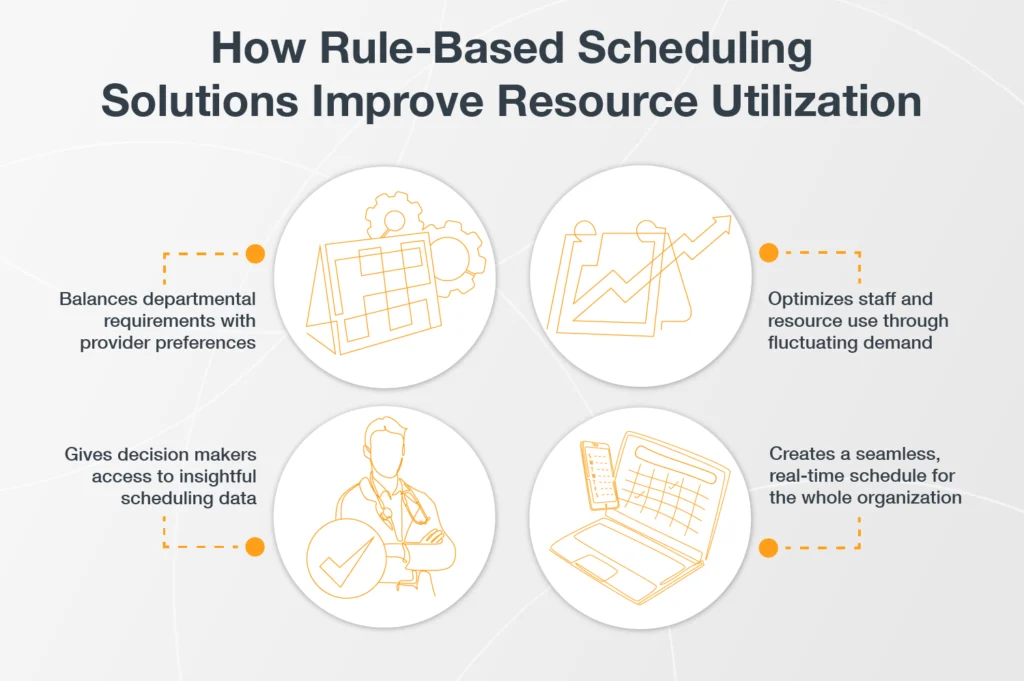Live Session
A Roadmap for Change Management Projects
Register NowTABLE OF CONTENTS

In the world of healthcare, the impact of provider and staff scheduling reaches far beyond any one person’s workload. Let’s look at a few key operational areas to learn why they can be so heavily influenced by scheduling.
A high-functioning healthcare organization requires each member of the care team to be visible and readily accessible. Like clockwork, the care team must be properly in sync to provide the best patient care possible, but this can be challenging when staff turnover is high. That’s why staff retention is so important. Of course, there are many things that contribute to job satisfaction, but advanced scheduling software can make a major impact in this area to improve overall staff longevity.
How, you ask? For starters, rule-based scheduling software can build equitable schedules for everything from a single department to a multi-site health system. This means all providers under a system umbrella can be given a more balanced shift load. Other capabilities include:
Combined, these capabilities work together to reduce burnout, increase schedule transparency, alleviate any hint of scheduling favoritism, and advance operational efficiency by making schedule builds much quicker.
Overall, rule-based scheduling can positively impact staff retention by balancing and optimizing workloads, expanding trust and transparency between medical staff and schedulers, and making up-to-date, easily accessible schedules the de facto standard rather than the exception.
It goes without saying that delays are detrimental to patient care. Unfortunately, many clinicians still struggle with communication-related obstacles that slow them down every day. Did you know that up to 40% of care team communication time is actually spent trying to find contact information for the correct provider?1 If you’re connecting the dots, you can see how real-time schedules and efficient communication go hand in hand. When critical details are incorrect—maybe the wrong provider is listed on the on-call schedule—delays (along with unnecessary care team toil) are hard to avoid.
Real-time schedules tailored to the unique structure and needs of the organization can mitigate these inefficiencies, ensuring more efficient patient treatment. A schedule updated in real time will always show the correct provider, meaning any time they’re needed for a matter related to patient care, the right provider can be contacted quickly. And going a step further, with additional integrations in place, scheduling software can be closely tied to the EHR, clinical directories, and more, all of which can help to accelerate care delivery.
Rule-based, optimized scheduling positively impacts care delivery by:
Resource utilization is another operational pillar that falls within the reach of scheduling. Done the right way, scheduling can be a powerful tool in the balancing act that is matching patient demand with clinicians, rooms, and equipment. Managing these resources manually takes a lot of time and makes it much more difficult to find an ideal (and accurate) balance. Further, it’s not always possible to catch mistakes and make adjustments in time when you’re using workflows that depend on Excel or paper and pencil.
Auto-generating an always-accurate, real-time schedule better prepares any organization to match patient demand with organizational requirements and available resources. This is accomplished by creating unique rules and building them into the back end of the system. The sky is essentially the limit when it comes to the complexity and specificity of these rules, which means schedules can be closely tailored to the needs of the department (or enterprise) to more effectively manage providers, rooms, and equipment. An advanced scheduling system should also offer useful analytics that give decision makers more comprehensive insight into the way provider time and other resources are being used.

For many organizations, moving to a rule-based scheduling solution would be a transformative step—one that makes optimizing personnel and resource utilization a top priority. By using advanced scheduling software to address staff satisfaction and retention, prevent care delays, and optimize resource use, any organization can become a more streamlined care-delivery machine. Because in healthcare, scheduling isn’t just about time—it’s about putting all the complicated pieces together to reliably orchestrate success.
For a deeper dive into what rule-based scheduling software can do for your organization, read How Scheduling Impacts Clinician Retention & Other Key Hospital Metrics: A Guide for Operations Leaders.
Sources:
1 Improving Patient Safety Through Provider Communication Strategy Enhancements, National Library of Medicine: https://www.ncbi.nlm.nih.gov/books/NBK43663/